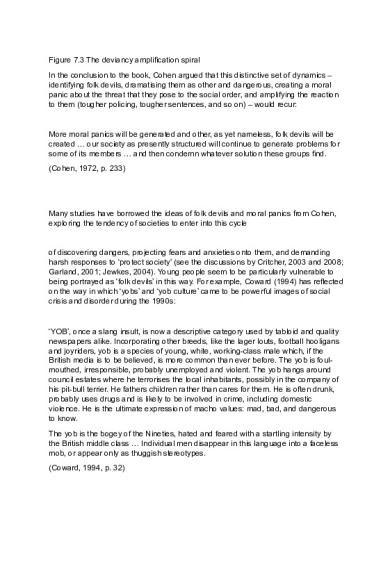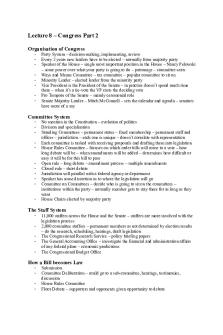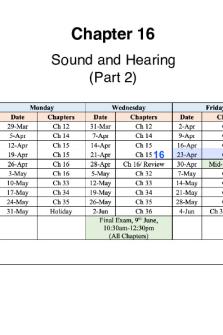Book 2 chapter 7 part 8 PDF

| Title | Book 2 chapter 7 part 8 |
|---|---|
| Author | georgia barber |
| Course | Introducing the social sciences |
| Institution | The Open University |
| Pages | 4 |
| File Size | 52.7 KB |
| File Type | |
| Total Downloads | 89 |
| Total Views | 155 |
Summary
in depth notes for this chapter in the dd102 module...
Description
Figure 7.3 The deviancy amplification spiral In the conclusion to the book, Cohen argued that this distinctive set of dynamics – identifying folk devils, dramatising them as other and dangerous, creating a moral panic about the threat that they pose to the social order, and amplifying the reaction to them (tougher policing, tougher sentences, and so on) – would recur:
More moral panics will be generated and other, as yet nameless, folk devils will be created … our society as presently structured will continue to generate problems for some of its members … and then condemn whatever solution these groups find. (Cohen, 1972, p. 233)
Many studies have borrowed the ideas of folk devils and moral panics from Cohen, exploring the tendency of societies to enter into this cycle
of discovering dangers, projecting fears and anxieties onto them, and demanding harsh responses to ‘protect society’ (see the discussions by Critcher, 2003 and 2008; Garland, 2001; Jewkes, 2004). Young people seem to be particularly vulnerable to being portrayed as ‘folk devils’ in this way. For example, Coward (1994) has reflected on the way in which ‘yobs’ and ‘yob culture’ came to be powerful images of social crisis and disorder during the 1990s:
‘YOB’, once a slang insult, is now a descriptive category used by tabloid and quality newspapers alike. Incorporating other breeds, like the lager louts, football hooligans and joyriders, yob is a species of young, white, working-class male which, if the British media is to be believed, is more common than ever before. The yob is foulmouthed, irresponsible, probably unemployed and violent. The yob hangs around council estates where he terrorises the local inhabitants, possibly in the company of his pit-bull terrier. He fathers children rather than cares for them. He is often drunk, probably uses drugs and is likely to be involved in crime, including domestic violence. He is the ultimate expression of macho values: mad, bad, and dangerous to know. The yob is the bogey of the Nineties, hated and feared with a startling intensity by the British middle class … Individual men disappear in this language into a faceless mob, or appear only as thuggish stereotypes. (Coward, 1994, p. 32)
■
Can you identify any current ‘folk devils’?
2.5
‘Society must be protected’: crises and control
One important study that drew on and extended Cohen’s work was by Stuart Hall and his colleagues (1978), which examined the construction of a moral panic about ‘mugging’ (street robbery) in Britain during the early 1970s. A term that had not been used since the nineteenth century was suddenly discussed in the mass media as a ‘frightening new strain of crime’, possibly arriving from what the British perceived as the violent, dangerous and racially divided USA. ‘Muggers’ became a new type of folk devil, identified as a threat to stability and social order, and requiring tough measures to protect society. Hall et al. argued that this
invention of ‘mugging’ needed to be understood as part of wider social and political dynamics. They explored the different sorts of disorder that shaped British society at the beginning of the 1970s: a deepening economic crisis and a stagnant economy; growing political conflict; a variety of social divisions that were becoming more severe; and a loss of public confidence in the nation’s political leaders. Describing a time in which a relatively consensual society in the 20-year period following the Second World War was becoming increasingly characterised by economic, social and political conflicts, they claimed that the figure of the ‘mugger’ was placed in the middle of this crisis. He (muggers were usually imagined as men – young, black men to be more precise) became the focus of social and political anxiety – the ‘mugger’ was seen to represent the breakdown of law and order. As a result, the mass media were full of denunciations, dire warnings and demands for tough action to be taken to save the country from this appalling threat. For Hall et al., this invention was a way of displacing genuine social and political tensions onto a folk devil. Attention could be deflected from the deepening crises. Society would be protected – not by overcoming divisions – but by ‘cracking down’ on young black men on the nation’s streets. Getting tough on mugging created new police powers, brought about ‘exemplary’ sentences for those found guilty of robbery (mugging was never a crime in a legal definition), and exposed young black men to a programme of systematic harassment by police officers (under what became known as the ‘sus’ law: the right of police officers to stop anyone that they suspected might have committed a crime or be intending to commit a crime). The ‘suspicious person’ powers derived from Section 4 of the Vagrancy Act 1824 and became a major point of conflict between the police and the black community in Britain (especially in London: see Whitfield, 2004). It was eventually abolished in the early 1980s (following the Scarman Report’s recommendation of the need for more integrative ‘community policing’) but re-emerged in a new guise as the power to ‘stop and search’. The new power continued to be deployed in an ethnically discriminatory way (what in the USA is known – and condemned – as ‘racial profiling’). Whitfield indicates that:
Ministry of Justice figures published in October 2007 reveal that black and Asian people are more likely to be stopped and searched than their white counterparts. This is especially the case in London where, in 2005/06, black people were more than seven times more
likely to be searched than whites. Outside London, they are 4.8 per cent more likely to be searched. (Whitfield, 2009)
For Hall et al., ‘mugging’ helped the politically dominant groups in Britain to move attention from social divisions and political conflict onto a group of folk devils, and to argue that society needed to be protected through tougher policing and a generally stronger state. In ‘cracking down’ on crime and violence, particularly among young black men, the state (seen by Hall et al. to be representing the most powerful groups and interests in society) became a ‘primary definer’ of disorder. The media then took their cue from government, police and judges – for instance, in the use of the term ‘mugging’ – and extended the primary definitions further, giving them a popular ring. In this view, the deep-seated causes of social conflict, chiefly inequality, were obscured and the issue was turned into a legal and moral struggle against what was defined as ‘mindless violence’. Hall and his colleagues described this as the creation of a ‘law and order society’ in which those defined as the enemies of the nation would be rooted out and subjected to increasingly harsh treatment. The analysis they presented has proved to be both very powerful (the book was reissued on its thirtyfifth anniversary in 2013) and very controversial. Debates about it continue that address its account of the British political situation, the relationship between institutions of social control and the mass media, and its view of the situation of young black men in Britain (see, for example, Jewkes (2004) and the special issue of the journal Crime, Media, Culture published in April 2008 (Clarke, 2008)). Perhaps the most interesting question that emerges from the Hall et al. study is whether we are still ‘policing the crisis’: deflecting attention away from economic crises, social divisions and political conflict by focusing too much on the deviant behaviour of young people and the need to impose a ‘law and order society’ (Clarke, 2008). Following the English riots of August 2011, it was possible to trace very different views: between those who denounced the ‘pure criminality’ of the rioters; those who sought to explain rioting in terms of the social and economic conditions facing young people (young men, in particular); and those who suggested that the reaction to the riots was also a displacement of larger social, economic and political crises onto a problem of crime. For this last group, policing the crisis remained an
important point of reference. The next chapter takes up the issue of rioting more fully.
Summary This section has explored how sociologists have studied the social reactions to disorderly behaviour, beginning from Becker’s view that ‘deviance’ is not an intrinsic property of an act, but a label applied to it. This view enables the study of how: ● some behaviours (and some types of people) come to be defined and labelled as deviant ● the media play a role in defining deviance and creating social anxiety or moral panics about some types of behaviour (and some types of people) ● agencies of social control (the police and the criminal justice system) may act in ways that concentrate on some types of people rather than others ● crime and the fear of crime may play a significant role in politics, including as a displacement of other problems and crises....
Similar Free PDFs

Book 2 chapter 7 part 8
- 4 Pages

Chapter 7 (Part 1)
- 2 Pages

Unit-8 - Text Book - Chapter 8
- 7 Pages

Chapter 7 & 8 Notes
- 7 Pages

Chapter 7-Part A: Efficiency
- 12 Pages

Week 8, Part 2 - Lecture notes 8
- 5 Pages

Lecture 8 - Congress Part 2
- 2 Pages

Chapter 16 Part 2
- 27 Pages

Neuroscience Part 2 Lecture 7
- 3 Pages

Chapter 2 smart book
- 64 Pages

Chapter 6 part 2
- 1 Pages

Chapter 1 Part 2
- 3 Pages

Blowfield book - Part 1
- 7 Pages

CHAPTER 6 , 7, 8, 9
- 20 Pages

Chapter 7/8 Case Briefs
- 18 Pages

MAN4301 Lecture 7 Chapter 8
- 5 Pages
Popular Institutions
- Tinajero National High School - Annex
- Politeknik Caltex Riau
- Yokohama City University
- SGT University
- University of Al-Qadisiyah
- Divine Word College of Vigan
- Techniek College Rotterdam
- Universidade de Santiago
- Universiti Teknologi MARA Cawangan Johor Kampus Pasir Gudang
- Poltekkes Kemenkes Yogyakarta
- Baguio City National High School
- Colegio san marcos
- preparatoria uno
- Centro de Bachillerato Tecnológico Industrial y de Servicios No. 107
- Dalian Maritime University
- Quang Trung Secondary School
- Colegio Tecnológico en Informática
- Corporación Regional de Educación Superior
- Grupo CEDVA
- Dar Al Uloom University
- Centro de Estudios Preuniversitarios de la Universidad Nacional de Ingeniería
- 上智大学
- Aakash International School, Nuna Majara
- San Felipe Neri Catholic School
- Kang Chiao International School - New Taipei City
- Misamis Occidental National High School
- Institución Educativa Escuela Normal Juan Ladrilleros
- Kolehiyo ng Pantukan
- Batanes State College
- Instituto Continental
- Sekolah Menengah Kejuruan Kesehatan Kaltara (Tarakan)
- Colegio de La Inmaculada Concepcion - Cebu